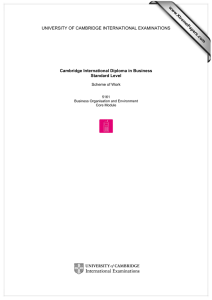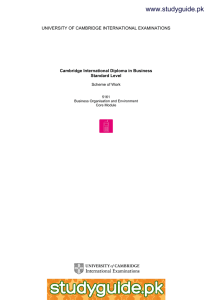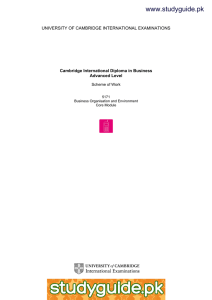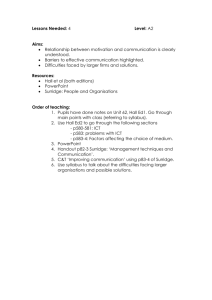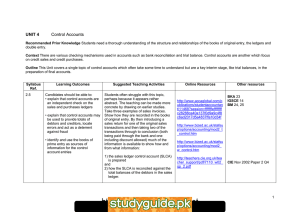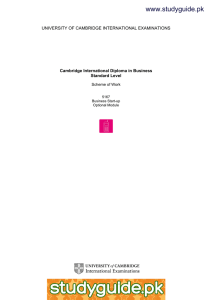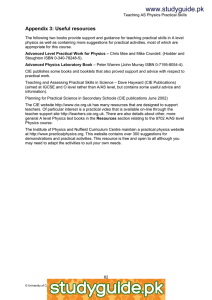www.XtremePapers.com
advertisement
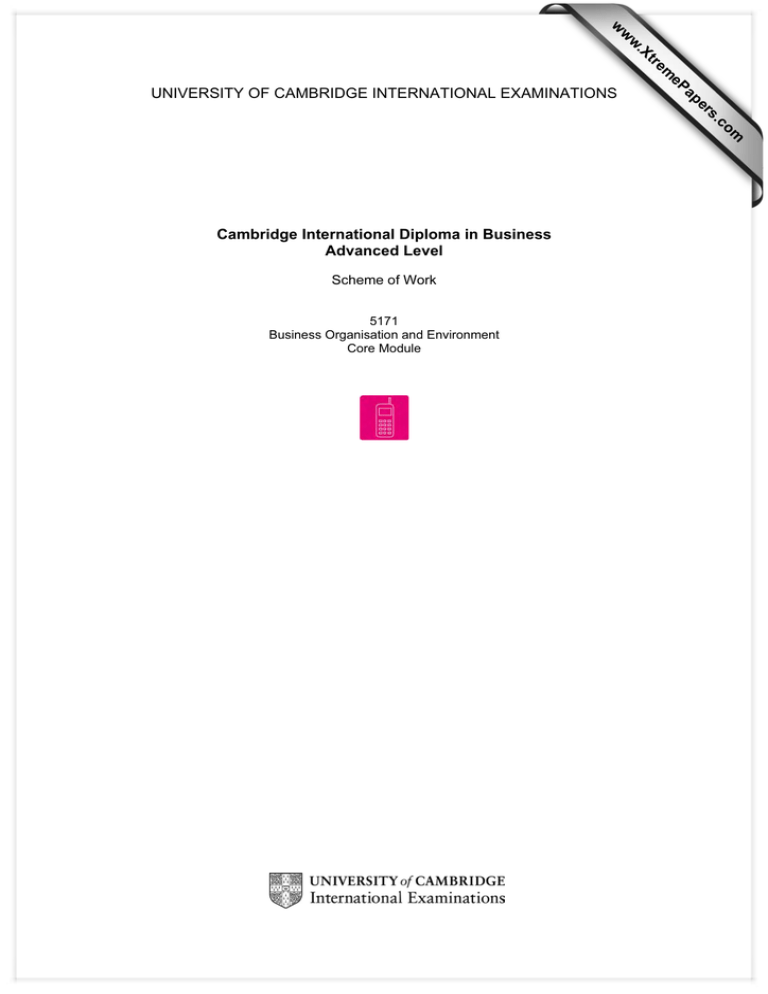
w w ap eP m e tr .X w UNIVERSITY OF CAMBRIDGE INTERNATIONAL EXAMINATIONS om .c s er Cambridge International Diploma in Business Advanced Level Scheme of Work 5171 Business Organisation and Environment Core Module Introduction The overall programme comprises three core and six option modules: Core Option Business Organisation and Environment Effective Business Communication Business Finance Marketing Human Resources Management Interpersonal Business Skills Business Start-Up Customer Care Information and communications technology The modules have been chosen to reflect the key areas of business. It is important that in the delivery of each module, tutors appreciate that the programme is concerned with Skills and Knowledge. Students should be encouraged not only to demonstrate their knowledge but also their acquisition and development of complementary skills. The programme has four general aims that are designed to encourage the students to: · · · · understand key concepts of business apply acquired skills to real work situations think about and resolve business problems work independently using their initiative The over-riding objective of the programme is to prepare students either for employment or, if already in employment, for advancement. Employers expect those completing the Cambridge International Diploma in Business modules to be able to offer a working combination of skills and knowledge. The accompanying scheme of work focuses specifically around the skills and knowledge of each competence criterion and clearly they must form the essence of the delivery of the modules. Business Organisation and Environment (5171) Advanced The module Business Organisation and Environment, being Advanced, requires a minimum of 60 learning hours. The scheme of work has been organised to offer those 60 hours within the class- or lecture-room setting and it is expected that additional learning time will be undertaken by students outside the timetabled hours working in study groups or undertaking independent study. The key to the module’s delivery is flexibility. There are several means at your disposal to help you deliver the module and the employment of an appropriate variety would be welcome. The standard or traditional class approach will still form the basis of much of your delivery but you might care to reinforce it by using the occasional outside or guest speaker, simulation, role-play, brainstorming session, or presentation. It is not necessary that you use them all during your teaching of this module but these alternatives will help to encourage more student interest in the subject area. There is, however, no substitute for a lively, motivating, and stimulating teacher! The main rule to follow is that you bring the module to life and make it relevant and interesting. It is assumed that you have ready use of the basic tools of whiteboard, flip chart and OHP and, additionally, you may have access to the Internet. Other resources that will be readily available include textbooks, newspapers and journals, balance sheets, resource packs (often © CIE 2002 2 given out by, for example, banks and insurance companies), past examination papers (in particular their case studies). Please do not overlook your own role in providing stimulus material e.g. task related to a current business event, photocopy of an article coupled with a discussion topic. It is quite important that you appreciate that the International Diploma in Business programme is holistic or integrated i.e. the modules, whilst each is designed to be studied individually, must be regarded as part of a whole course and a wider experience. A brief research of the modules in the syllabus compendium will indicate how the various modules have common areas and interlink with one another. The Scheme of Work You may have to revise or change the accompanying scheme to suit your own purposes but it offers an advised approach to Business Organisation and Environment. Activities or activity suggestions are included in the scheme but there may be more than you can use. Please keep in mind that 5171 is an examined module i.e. your students will sit a two-hour written paper in either May or October. It is helpful to your students that they have frequent tasks and assignments to complete and access to past papers. The object of the scheme of work is to: · · · · · offer you a guide and help to keep you on track throughout the delivery of the module give you structure and purpose to your teaching identify what and how you are going to teach indicate what resources you will require indicate how many pieces of work you will issue and to suggest their form The scheme of work is broken down into a series of session plans and there is a guide as to how much time each plan might take to deliver. It is not the intention that, necessarily, you spend two or three hours on a session plan in one teaching session but as you will know the timeframes for your classes so you must adjust the scheme accordingly. © CIE 2002 3 Scheme of Work 1.0 Understand and describe the features and objectives of business organisation Session Plan One Competence Criteria · demonstrate understanding of the economy and its business context (1.1) · analyse and explain differing economic and political factors (4.1) Skills and Knowledge · economy: the economy as a dynamic force; market, planned and mixed economies · enterprise: the need to encourage enterprise; the business culture; competitiveness. · policies: policies to encourage the establishment of business especially small and medium enterprises; inward investment; job creation schemes Notes on delivery and activities Duration in hours The object is to establish the context in which business exists and operates. There is the need to impart detail about policies affecting business. Presentation of theory with reference to and supported by practical examples. General discussion about policies. Tutorial summary Activity One: Working in groups of three, ask the students to identify at least three features each of planned, mixed and market economies. Encourage brief feedback to the class. Resources: · · · Lines, Marcouse and Martin The Complete A-Z Business Studies Handbook Marcouse, Gillespie, Martin, Surridge and Wall, Business Studies Hall Jones and Raffo, Business Studies, Units 1, 6 and 8 Online Resources: · · · www.bized.ac.uk www.dti.gov.uk www.3i.co.uk © CIE 2002 4 2½ Session Plan Two Competence Criteria · recognise and explain the objectives of business organisations (1.2) Skills and Knowledge · definitions of business and business organisation · objectives: profit, market penetration, economic survival, satisfying customer demand, improving sales revenue, remain competitive, respond to changing external environmental pressures, help to provide employment and better living standards Notes on delivery and activities Duration in hours Presentation of theory with clear reference to practical examples and situations. The starting point needs to be profit and the justification for enterprise. 2½ Note that the response to changing external environmental pressures will be covered in detail under assessment objective 4.0. Tutorial summary Resources: · · · Lines, Marcouse and Martin The Complete A-Z Business Studies Handbook Marcouse, Gillespie, Martin, Surridge and Wall, Business Studies Hall Jones and Raffo, Business Studies, Units 5 and 7 Online Resources: · · · www.bized.ac.uk www.dti.gov.uk www.carol.co.uk Assignment 1 Business and Government Discuss the idea that the Government should not intervene with any policy to create or stimulate employment as that is the joint function of market forces and employers. © CIE 2002 5 Session Plan Three Competence Criteria · identify and compare forms and features of business organisations (1.3) Skills and Knowledge · classification by sector: private – sole trader, partnership, private company, public limited company; mutuality – co-operative, charity public - local government, central government, public corporations, nationalised industry · legal requirements: features of different types of business; registration; business legislation Notes on delivery and activities Duration in hours Presentation of theory with clear reference to practical examples and situations. This is an extensive area and students need to understand the essential differences between the various types and forms of business. Tutorial summary Activity Two: Create a worksheet on features of business organisations and hand it out to the class. The worksheet needs to be headed with the forms of business with the left-hand column identifying the main features. The students can fill it in so reinforcing what has been taught. (see suggested worksheet) Resources: · · · Lines, Marcouse and Martin The Complete A-Z Business Studies Handbook Marcouse, Gillespie, Martin, Surridge and Wall, Business Studies Hall Jones and Raffo, Business Studies, Units 3, 4 and 31 Online Resources: · · · www.bized.ac.uk www.dti.gov.uk www.companieshouse.gov.uk © CIE 2002 6 2½ Activity Two Worksheet Fill in each box, as appropriate, so that you have an easy reference comparative chart on the features of business organisations. Features Sole trader Partnership Private Company Number of members: Minimum Maximum Stock exchange Quotation Separate legal identity Liability in the event of Bankruptcy Management control Ownership Voting rights Maximum shareholding (per shareholder) Disposal of shares Minimum capital (required for company registration) © CIE 2002 7 Public Limited Company Co-operative Society Session Plan Four Competence Criteria · understand and describe the basic elements of business finance (1.4) Skills and Knowledge · finance: shareholding (ordinary and preference), loans (debentures) ploughed-back profits, venture capital, bank loans and over-drafts, leasing, trade credits · costs: overheads, direct and indirect, fixed and variable, marginal, budgeting, break-even Notes on delivery and activities Duration in hours Presentation of theory but reinforced with practical examples. Balance sheets would be useful resource materials. Tutorial summary Activity Three: Hand out balance sheets and ask the students to identify various simple financial issues e.g. sources of funds. Activity Four: Working in groups of three, ask the students to “invest” $5,000 in three to five companies, and then tack the movements of the shares over, say, 20 trading days. At the end of that time they can determine their profit or loss. Resources: · · · Lines, Marcouse and Martin The Complete A-Z Business Studies Handbook Marcouse, Gillespie, Martin, Surridge and Wall, Business Studies Hall Jones and Raffo, Business Studies, Units 11, 39, 40 and 46 Online Resources: · · www.bized.ac.uk www.dti.gov.uk © CIE 2002 8 2½ Session Plan Five Competence Criteria · identify and explain the elements of business planning (i) (1.5) Skills and Knowledge · mission statement: its role, statement of aims · strategies: importance of establishing strategies for marketing, pricing and workforce planning Notes on delivery and activities Duration in hours Presentation of theory but reinforced with practical examples. Use some real mission statements obtained either from balance sheets or from companies. The strategies should be realistic and based on working situations. Tutorial summary Resources: · · · Lines, Marcouse and Martin The Complete A-Z Business Studies Handbook Marcouse, Gillespie, Martin, Surridge and Wall, Business Studies Hall Jones and Raffo, Business Studies, Units 7, 8, 21, 23 and 51 Online Resources: · · · www.bized.ac.uk www.dti.gov.uk www.carol.co.uk © CIE 2002 9 2 Session Plan Six Competence Criteria · identify and explain the elements of business planning (ii) (1.5) Skills and Knowledge · external influences: monitor and assess their likely impact · goals: process of setting goals and targets and their achievement · forecasts: process of short, medium and long term forecasting of turnover, profit, production, employment needs Notes on delivery and activities Duration in hours Presentation of theory but reinforced with practical examples. It is only necessary to introduce the issue of external influences as this will be covered in detail under assessment objective 4.0. 2 Goals and forecasts are extensions to strategies Tutorial summary. Resources: · · · Lines, Marcouse and Martin The Complete A-Z Business Studies Handbook Marcouse, Gillespie, Martin, Surridge and Wall, Business Studies Hall Jones and Raffo, Business Studies, Units 7, 15 and 65 Online Resources: · · www.bized.ac.uk www.dti.gov.uk Assignment 2 Chan Industrials Plc A row has broken out between two of the executives of Chan Industrials about human resource or workforce planning. The Finance Director is always looking to cut labour costs but the Production Director is complaining that constant interference with the labour schedules makes it difficult to achieve smooth and reliable production. Her view is that the problem is not the size of the labour force, but the fact that the company has not properly assessed and planned its labour requirements. Set out your reaction to this argument i.e. is the Finance Director right and should labour costs be reduced as an on-going policy? Or is the Production Director’s case more appropriate? Does it call for a proper human resource planning policy? What additional information would you need to decide who is right? © CIE 2002 10 2.0 Investigate and explain the internal structure of a business organisation Time allocated to this assessment objective 11½ hours Session Plan Seven Competence Criteria · research and outline the factors determining the structure of a business organisation (2.1) Skills and Knowledge · purpose: means to coordinate resources distribute work, monitor company performance, set and achieve targets, identify and pursue objectives, resolve problems · types: line, functional, line and staff, committee, matrix; centralisation/decentralisation, nature and size of business as a factor determining structure · working arrangements: divisions, departments, team working, quality circles Notes on delivery and activities Duration in hours Presentation of theory but reinforced with practical examples. The delivery can focus on perhaps two organisations – one small and one large (choose those organisations which can be researched easily). 3 Tutorial summary. Activity Five: Create the basic details of an organisation and ask the students to draw up a plausible structure plan, the results to be fed back to the class. Resources: · · · Lines, Marcouse and Martin The Complete A-Z Business Studies Handbook Marcouse, Gillespie, Martin, Surridge and Wall, Business Studies Hall Jones and Raffo, Business Studies, Units 2, 5, 50 and 63 Online Resources: · · www.bized.ac.uk www.dti.gov.uk Assignment 3 Organisation Chart 1) Draw up a structure i.e. an organisational chart, of a company that is familiar to you or one which will offer you the relevant information. This organisation may be your educational institution, your employer (full or part-time), or your family’s business. 2) When you have completed the structure, identify its type (e.g. matrix, line) and discuss in general terms whether you think it is appropriate for the organisation. 3) Set out in list form what you understand are the purposes of an organisational structure. © CIE 2002 11 Session Plan Eight Competence Criteria · examine and compare the roles and duties of people in the organisation (i) (2.2) Skills and Knowledge · roles and functions of managers: duties and powers of directors · leadership styles (autocratic democratic, laissezfaire) · chain of command and span of control Notes on delivery and activities Duration in hours Presentation of theory with reference to practical examples. The delivery should link with topic 2.1. A key point is that a limited liability business is considered in law to be an artificial legal person. Tutorial summary Activity Six: Working in groups of three, ask the students to set down, in an order of priority, what they think are the functions of a senior manager. Encourage feedback to the class. Resources: · · · Lines, Marcouse and Martin The Complete A-Z Business Studies Handbook Marcouse, Gillespie, Martin, Surridge and Wall, Business Studies Hall Jones and Raffo, Business Studies, Units 2, 3, 58 and 63 Online Resources: · · www.bized.ac.uk www.dti.gov.uk © CIE 2002 12 3 Session Plan Nine Competence Criteria · examine and compare the roles and duties of people in the organisation (ii) (2.2) Skills and Knowledge · motivational methods and theories e.g. Maslow, McGregor, Herzberg · the working climate and opportunities for employee participation. Notes on delivery and activities Duration in hours This is largely a theoretical presentation. The emphasis should be on the readily applicable aspects of the theories. Some practical application and reference should be made. Tutorial summary Resources: · · · Lines, Marcouse and Martin The Complete A-Z Business Studies Handbook Marcouse, Gillespie, Martin, Surridge and Wall, Business Studies Hall Jones and Raffo, Business Studies, Units 48, 49 and 50 Online Resources: · · www.bized.ac.uk www.dti.gov.uk © CIE 2002 13 2 Session Plan Ten Competence Criteria · understand and outline the systems of communication written within an organisation (2.3) Skills and Knowledge · nature and purpose of communication: imparting information, orders, requests, formal and informal, style and nature appropriate to organisational structure · clarity, tone, content, jargon, flow – vertical and horizontal, oral, verbal, written, textual, visual, electronic Notes on delivery and activities Duration in hours Presentation of theory but ample opportunity for practical exercises. Tutorial summary Activity Seven: Working in groups of three, ask the students to write: 1) 2) a memorandum to the Human Resources Director suggesting an increase in salary for an employee (the students can choose the detail) a letter to a supplier who on the last three occasions delivered the orders two days late (students to decide the details) Feedback to the class. Resources: · · · Lines, Marcouse and Martin The Complete A-Z Business Studies Handbook Marcouse, Gillespie, Martin, Surridge and Wall, Business Studies Hall Jones and Raffo, Business Studies, Units 62 Online Resources: · · www.bized.ac.uk www.dti.gov.uk © CIE 2002 14 3½ 3.0 Investigate and compare employment arrangements in business organisations Time allocated to this assessment objective 11½ hours Session Plan Eleven Competence Criteria · identify different types of employment arrangements in business organisations (i) (3.1) Skills and Knowledge · nature and conditions of work: permanent, temporary, casual, fixed term, one year rolling contracts, full-time, part-time, flexitime, job sharing, multiple employment, self-employment, freelance Notes on delivery and activities Duration in hours Presentation of theory with practical examples drawn from business organisations. The emphasis, depending on what is happening in your economy, should be on the changing nature and types of employment arrangements. Tutorial summary Activity Eight: Working in their groups of three, give the students the task of listing the different employment arrangements discussed under this topic and identifying at least three features of each. Resources: · · · Lines, Marcouse and Martin The Complete A-Z Business Studies Handbook Marcouse, Gillespie, Martin, Surridge and Wall, Business Studies Hall Jones and Raffo, Business Studies, Units 51, 52 and 53 Online Resources: · · · www.bized.ac.uk www.dti.gov.uk www.ipd.co.uk © CIE 2002 15 3 Session Plan Twelve Competence Criteria · identify different types of employment arrangements in business organisations (ii) (3.1) Skills and Knowledge · features and structure of the work base: shop, factory, laboratory, office, home · changing and increasing use of technology: design, production, sales, teleworking · problems posed by new technology: training, skills shortages, · employment arrangements: hours, pay, incentives, lighting, temperature, air conditioning Notes on delivery and activities Duration in hours Presentation of theory with practical examples drawn from business organisations. The emphasis, depending on what is happening in your economy, should be on the effect of technology and possibly the changes in the work base e.g. teleworking 2½ Tutorial summary Resources: · · · Lines, Marcouse and Martin The Complete A-Z Business Studies Handbook Marcouse, Gillespie, Martin, Surridge and Wall, Business Studies Hall Jones and Raffo, Business Studies, Units 36, 51 and 54 Online Resources: · · · www.bized.ac.uk www.dti.gov.uk www.ipd.co.uk Assignment 4 Technology and Madhav Components The company makes extensive use of computer technology. All executive and sales staff are equipped with laptops so that when they are out or away on business they can work and also keep in touch with the head office. This has given the Director of Human Resource Management the idea that some staff need not come into work at all but can, given the appropriate equipment, training and support, just as easily work at and from home. Their work can be monitored at any time and it is bound to save costs. In some countries, home or teleworking is developing fast and some say it won’t be too long before it is a major feature of employment. Explain what you think are the both the advantages and disadvantages of teleworking to 1) Madhav Components 2) to the employees affected by the proposal © CIE 2002 16 Session Plan Thirteen Competence Criteria · investigate and demonstrate awareness of the rights and responsibilities of employers and employees (i) (3.2) Skills and Knowledge · employers’ expectations of employees: co-operation, work effectively and efficiently, commitment to the business and its objectives, loyalty, acceptance of company codes of conduct, manage time effectively, have or acquire appropriate skills undertake any work that may be reasonably asked of them Notes on delivery and activities Duration in hours Presentation of theory with practical examples drawn from business organisations like the issue of company codes of conduct. Time management can be discussed both in the context of the topic and the way the students approach the course. Tutorial summary. Resources: · · · Lines, Marcouse and Martin The Complete A-Z Business Studies Handbook Marcouse, Gillespie, Martin, Surridge and Wall, Business Studies Hall Jones and Raffo, Business Studies, Units 52, 53, 54, 60 and 61 Online Resources: · · · www.bized.ac.uk www.dti.gov.uk www.ipd.co.uk © CIE 2002 17 2½ Assignment 5 Role Play Preparation Here are two situations and you are to produce two arguments for each case: one from the employer’s position and the other from the employee’s point of view. Be prepared to contribute to the role-play in class under activity Nine: 1) Company A wants to update its corporate image and now expects all the staff to wear the company uniform. Men will be in Italian styled suits with silk shirts and ties and the women will dress in almost the same way except they will wear knee-length skirts instead. There is general approval for the new look but there are a number of Muslim women who want to wear trousers and keep their heads covered. The company will not deviate from its policy and has threatened disciplinary action if anyone disobeys. Shubnam has been appointed to represent the Muslim women. She has an interview to attempt to convince management to respect the wishes of those she represents. 2) In Company B there is a growing number of minor accidents in the factory and Jawad has received several injuries in the course of his work. The machines are not fitted with reliable protection and Jawad believes it is only a matter of time before a serious, even fatal, incident occurs. He is a loyal employee and not given to causing trouble but he feels strongly that something must be done to protect employees using machinery. The company says that employees know the risks and if anyone is injured then it is a case of contributory negligence. Jawad has been called into the Production Director’s office to put his case. © CIE 2002 18 Session Plan Fourteen Competence Criteria · investigate and demonstrate awareness of the rights and responsibilities of employers and employees (ii) (3.2) Skills and Knowledge · employees’ expectations of employers: payment of fair wages and salaries, appropriate financial and non-financial incentives, opportunities for advancement, understand role of trade union or staff association, provide suitable and safe conditions of work, offer training and retraining, provide means of resolving disputes and grievances, provide channels of communication, consultation and negotiation Notes on delivery and activities Duration in hours Presentation of theory with practical examples drawn from business organisations. Tutorial summary Activity Nine: Role-Play: using the cases in assignment 5, organise role-plays with two students at a time – one playing the employer and the other the employee. There is sufficient material under Skills and Knowledge to create additional scenarios. Tutorial summary and discussion. Resources: · · · Lines, Marcouse and Martin The Complete A-Z Business Studies Handbook Marcouse, Gillespie, Martin, Surridge and Wall, Business Studies Hall Jones and Raffo, Business Studies, Units 48, 49, 50, 55 56, 60 and 61 Online Resources: · · · www.bized.ac.uk www.dti.gov.uk www.ipd.co.uk © CIE 2002 19 3½ 4.0 Research and discuss the influences of the environment on business organisations Time allocated for this assessment objective 12 hours Session Plan Fifteen Competence Criteria · analyse and explain differing economic and political factors (4.1) · demonstrate understanding of the economy and the business context (1.1) Skills and Knowledge · economic: market. planned and mixed economies · political: attitudes towards business, power and influence of political parties, role of public opinion, influence and role of complementary business organisations – trade associations, pressure groups. Notes on delivery and activities Duration in hours Not entirely a theoretical approach as this topic relies on direct knowledge and understanding of political and economic issues. 2½ Activity Ten: Working in groups of three, ask the students to collect the names and objectives of five pressure groups and five trade associations. Feedback to the class. Resources: · · · Lines, Marcouse and Martin The Complete A-Z Business Studies Handbook Marcouse, Gillespie, Martin, Surridge and Wall, Business Studies Hall Jones and Raffo, Business Studies, Units 8, 10, 65 and 71 Online Resources: · · www.bized.ac.uk www.dti.gov.uk Assignment 6 External influences on business Using the detail discussed in class and researching on your own, explain how three external pressures and influences in your economy are likely to affect any particular sector of business or specific business organisation. © CIE 2002 20 Session Plan Sixteen Competence Criteria · recognise and understand the factors influencing business operation (i) (4.2) Skills and Knowledge · supply and demand: population trends e.g. people in work, age groups, types and availability of consumer credit, price levels, disposable income, consumer preference, impact of advertising, degree of competition Notes on delivery and activities Duration in hours Presentation will have a theoretical base but examples need to be drawn from real cases. Tutorial summary Resources: · · · Lines, Marcouse and Martin The Complete A-Z Business Studies Handbook Marcouse, Gillespie, Martin, Surridge and Wall, Business Studies Hall Jones and Raffo, Business Studies, Units 22, 23, 44, 51 and 68 Online Resources: · · www.bized.ac.uk www.dti.gov.uk © CIE 2002 21 2 Session Plan Seventeen Competence Criteria · recognise and understand the factors influencing business operation (ii) (4.2) Skills and Knowledge · government policies: control of inflation, indirect and direct taxation, level of government spending, interest rates, measures to influence the trade cycle. Notes on delivery and activities Duration in hours Presentation calls for a mixture of theory and practical application and interpretation. Use of actual tax/inflation/interest rates etc. to illustrate issues. Tutorial summary Resources: · · · Lines, Marcouse and Martin The Complete A-Z Business Studies Handbook Marcouse, Gillespie, Martin, Surridge and Wall, Business Studies Hall Jones and Raffo, Business Studies, Units 65, 66 and 67 Online Resources: · · www.bized.ac.uk www.dti.gov.uk © CIE 2002 22 2½ Session Plan Eighteen Competence Criteria · recognise and understand the factors influencing business operation (iii) (4.2) Skills and Knowledge · legislation: appropriate legislation affecting competition, business procedures, consumer protection · business confidence and activity: levels of productivity, economic growth, competitiveness and threats from overseas, levels of home and inward investment, workforce skills and flexibility, trade Notes on delivery and activities Duration in hours Presentation is largely factual and drawn from reality. Like session plans fifteen to seventeen, reference must be made to the political/legal/economic/social situation and trends in your country. Tutorial summary. Activity Eleven (a): In preparation for session plan nineteen, the students should obtain any information e.g. article, about a current business location issue in order to contribute to general class response. Resources: · · · Lines, Marcouse and Martin The Complete A-Z Business Studies Handbook Marcouse, Gillespie, Martin, Surridge and Wall, Business Studies Hall Jones and Raffo, Business Studies, Units 37, 67, 69 and 73 Online Resources: · · www.bized.ac.uk www.dti.gov.uk © CIE 2002 23 2½ Session Plan Nineteen Competence Criteria · understand the reasons for the location of business (4.3) Skills and Knowledge · economic: transport infrastructure, availability of labour, access to markets, access to resources, local and regional economic growth · incentives: investment allowances/grants, preferential business taxes, government subsidies to allow modernisation, employment creation schemes · environmental: local and national location policy, social costs i.e. private benefits plus externalities – ecological problems (air, water, land pollution, congestion, noise, dangerous chemicals), influence of pressure groups Notes on delivery and activities Duration in hours This is a large issue which needs both the theoretical and practical approaches. There are many examples of location and environmental issues which can be used to reinforce the topic. Tutorial summary Activity Eleven (b): Using the information gathered in activity Eleven (a), encourage class contributions and discussion. Resources: · · · Lines, Marcouse and Martin The Complete A-Z Business Studies Handbook Marcouse, Gillespie, Martin, Surridge and Wall, Business Studies Hall Jones and Raffo, Business Studies, Units 30, 37, 70, 71 and 72 Online Resources: · · www.bized.ac.uk www.dti.gov.uk © CIE 2002 24 2½ Assignment 7 Bhatiani Chemical Plant Bhatiani Chemical Corporation is to build a new chemical plant on a 50 hectare site in an area of outstanding natural beauty. The area is one of subsistence farming and fishing, low earnings and living standards, poor infrastructure, and unemployment. The Chairman of the BCC reckons that the plant will boost the local economy and has dismissed the objections of environmentalists as unreasonable, unrealistic and unintelligent. “The people have a right to a better life. It’s either the chemical plant and prosperity or a continuation of poverty.” Consider the situation and then advise: 1) 2) 3) 4) what economic benefits the plant might bring to the area what incentives you think the local and/or national government might have offered the company what impact the plant is likely to have on the local environment whether or not you would have approved the decision to let BCC build the plant and give your reasons © CIE 2002 25 5.0 Investigate and understand the relationship of the business to its markets Time allocated to this assessment objective 11 hours Session Plan Twenty Competence Criteria · demonstrate awareness of the nature of markets and market objectives (i) (5.1) Skills and Knowledge · the market place: domestic, international, global · ways of conducting business: local agents, permits, planning permission, costs of penetrating markets, government policies to encourage/deter trade (subsidies, tax breaks) Notes on delivery and activities Duration in hours Presentation of marketing theory and practice. Delivery should include reference to actual market situations. Tutorial summary Activity Twelve: Ask the students to visit a large retail store and list all the sales promotional schemes and any methods used to retain customer loyalty. Resources: · · · Lines, Marcouse and Martin The Complete A-Z Business Studies Handbook Marcouse, Gillespie, Martin, Surridge and Wall, Business Studies Hall Jones and Raffo, Business Studies, Units 18, 19 and 21 Online Resources: · · www.bized.ac.uk www.dti.gov.uk © CIE 2002 26 2 Session Plan Twenty-one Competence Criteria · demonstrate awareness of the nature of markets and market objectives (ii) (5.1) Skills and Knowledge · market objectives: achieve/maintain targeted market share, develop range of saleable products, establish image of products and firm, market decisions research, marketing mix, planning Notes on delivery and activities Duration in hours Theory and practice of marketing. The marketing mix, particularly, offers ample opportunity and example to illustrate and reinforce marketing principles. 2 Tutorial summary Resources: · · · Lines, Marcouse and Martin The Complete A-Z Business Studies Handbook Marcouse, Gillespie, Martin, Surridge and Wall, Business Studies Hall Jones and Raffo, Business Studies, Units 9, 20 and 21 Online Resources: · · www.bized.ac.uk www.dti.gov.uk Assignment 8 GoMe Ltd GoMe was set up a year ago by Khalid Goni and Ataul Meah who have a background in manufacturing protective clothing and equipment for the construction industry. They decided to concentrate initially on three lines – industrial footwear, hard hats, and ‘Dayglo’ yellow “Hi-Viz” jackets. They argue that at any one time in the world there are lots of properties which have to be demolished, renovated or built, so there should be no shortage of a market. After a year they have secured a small but respectable domestic market but are anxious for overseas orders. They reckon that with low production costs and a positive marketing attitude they can do very well with overseas sales. They have retained you to advise them on their marketing strategy. Bearing in mind the product and the targeted industry, advise GoMe on a marketing strategy comprising the research, the mix, and the planning needed to break into the overseas market. © CIE 2002 27 Session Plan Twenty-two Competence Criteria · demonstrate familiarity with the determination and application of prices (i) (5.2) Skills and Knowledge · influences on pricing: competition, position in the market, size of the market, state of the economy, availability of substitute goods and services · pricing methods: cost-plus, absorption cost, contribution, penetration, market-led, market skimming, destroyer, customer-value, price-discrimination, discounts and sales Notes on delivery and activities Duration in hours Mostly drawn from theory of prices but application to actual situations, policies and products is appropriate. Tutorial summary Activity Thirteen: Give the students a worksheet and ask them to put the following pricing methods under the appropriate headings: penetration, destroyer, close bid, absorption, skimming, customer value, contribution, going rate, cost-plus, price discrimination, discount and sales (see worksheet) Resources: · · · Lines, Marcouse and Martin The Complete A-Z Business Studies Handbook Marcouse, Gillespie, Martin, Surridge and Wall, Business Studies Hall Jones and Raffo, Business Studies, Units 22 and 23 Online Resources: · · www.bized.ac.uk www.dti.gov.uk © CIE 2002 28 2½ Activity Thirteen: Enter the following pricing methods under the appropriate headings: Absorption Customer value Penetration Cost based © CIE 2002 Close-bid Destroyer Price discrimination Contribution Discount Sales Cost-plus Going rate Skimming Market-led Competition based 29 Session Plan Twenty-three Competence Criteria · demonstrate familiarity with the determination and application of prices (ii) (5.2) Skills and Knowledge Purpose and application of break-even analysis, assessment of both price and cost changes upon profit, calculate the point of break-even, monitor fixed and variable costs, calculate the margin of safety. Notes on delivery and activities Duration in hours Deliver use of the break-even chart and contribution method. This links with session plan four. Make this a practical exercise based topic. Tutorial summary Activity Fourteen: Create a range of break-even calculations reflecting loss, break-even and profit situations. Resources: · · · Lines, Marcouse and Martin The Complete A-Z Business Studies Handbook Marcouse, Gillespie, Martin, Surridge and Wall, Business Studies Hall Jones and Raffo, Business Studies, Unit 11 Online Resources: · · www.bized.ac.uk www.dti.gov.uk © CIE 2002 30 2½ Session Plan Twenty-four Competence Criteria · appreciate and understand the importance and role of customer service. Skills and Knowledge · customers: main company resource, their contribution to profit, employment, company success · customer services: need to develop loyalty and business e.g. enquiry facility, handling complaints, refunds or replacements; appropriate sales methods – direct, indirect; customer profile and psychological factors Notes on delivery and activities Duration in hours Delivery needs to focus on the actual issues. Contact with selected companies will produce copies of customer service policies/agreements. Emphasis on the customers and their importance to the business. 2 Tutorial summary. Resources: · · · Lines, Marcouse and Martin The Complete A-Z Business Studies Handbook Marcouse, Gillespie, Martin, Surridge and Wall, Business Studies Hall Jones and Raffo, Business Studies, Units 1, 18 and 25 Online Resources: · · www.bized.ac.uk www.dti.gov.uk Assignment 9 Customer Service For several weeks, the sales staff of Transworld Retailing have been attempting to deal with some very difficult customers who have been rude, awkward, moody, domineering, very fussy and have made impossible demands regarding delivery dates, styling, colour, prices and contract terms. The sales staff have been put under a lot of pressure. It has now been revealed that the socalled customers were actors hired by the Managing Director and it appears that some of the telephone enquiries were conducted by the MD herself. At the monthly sales meeting, the last one held only yesterday, the MD was asked the inevitable question, “Why did you do this to us?” The MD stared at the questioner and said, “I ought to sack you for asking that question”. We are in a highly competitive world and my reasons should be obvious to everyone – including you!” Explain and justify the Managing Director’s actions and attitude. © CIE 2002 31 Suggested Resources Lines, Marcouse and Martin The Complete A-Z Business Studies Handbook Marcouse, Gillespie, Martin, Surridge and Wall, Business Studies Hall Jones and Raffo, Business Studies Newspapers – business pages Specialist journals (generally issued by the professional bodies) Surfing the Internet: regular surfing will reveal useful sources of supportive information but bear in mind that there is always a chance that some websites will close down or that you may have to register and/or subscribe. Examples, correct at the time of publication, include: www.bized.ac.uk Business Education www.carol.co.uk Company Annual Reports On-Line www.cbi.org.uk Confederation of British Industry www.dti.gov.uk Department of Trade and Industry http://europa.eu.int/index-en.htm European Union www.ipd.co.uk Institute of Personnel Development www.companieshouse.gov.uk Registrar of Companies You need to check what is available in your own country. © CIE 2002 32

